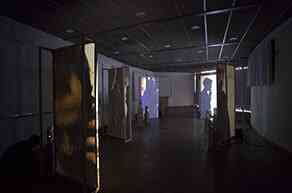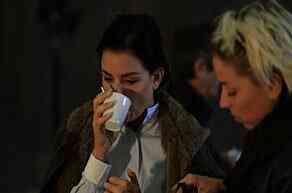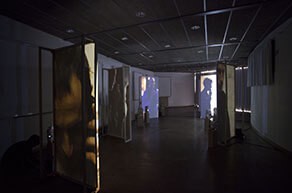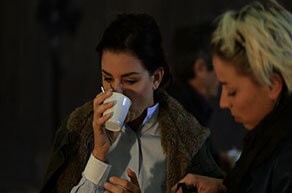Mathilde Supe
Mathilde Supe is Samantha Rees is an Astérides Resident in 2015. The archives of Triangle-Astérides do not allow for the determination of the exact dates or the duration of this residency in 2015.
Under the roof of a riding ring unfolds a ballet of makeup brushes and note-taking, of waiting and negotiation. A spotlight passes, the focus is set. It’s going to rain. It rains. The pointer positions himself facing the camera… smiles at us. Is that really orthodox? At times, a woman seems to be playing the role of an actress.
At first glance, it’s difficult to trace the contours of an inaugural artistic practice; however, even if Mathilde Supe is only at the sketch stage of her work, its lines are already strongly marked. Working as a set decorator assistant on film sets right after earning her baccalaureate, it was with the precision of a perfectionist prop maker that she entered the École Nationale Supérieure d’Arts Paris-Cergy to study set design. Her path then traced a harmonious curve, for it was a completely different kind of editing she learned there: video editing.
While working on a film by Patricia Mazuy, where the cinematographer Caroline Champetier—who has brought the profession to its peak—was operating, the desire arose to make a film using scraps, a chiaroscuro found footage à la Caravaggio. Due to image rights, the project was aborted. But Supe, persistent, did not give up: she would re-enact everything, as she had noted it all down meticulously.
Documentary or staged shooting, Hors Champ is certainly a film about a film being made. Contrary to its title, everything not supposed to appear is here adjusted, framed. We discern no heroine nor linear narrative, but a choreography of outstretched arms, pointed fingers, repeated lines, calculated measurements, and blush being applied. One recalls Truffaut’s face appearing at the “cut!” in Day for Night… And yet, here, not a single word is heard: even when the focus is made on a face, the sound takes us elsewhere. Birdsong, the sound of rain, the hum of distant farming machines distract our gaze—we are apparently never within earshot.
An autotelic project, focused on the production of images before they are offered to the viewer, Hors Champ seems to serve only cinema itself, extending to what happens between takes, up to the final clap—on which we read: “Hors Champ, sequence C(15), take 1A, October 2011.” We had our doubts.
Two years later, Mathilde Supe assists Keren Cytter on a catastrophic shoot and recounts the adventure in what resembles a logbook: Keren Cytter doesn’t like to share (2013). This book also reveals the seams of production as a landscape, and its expression is distinctly cinematic.
It is impossible to separate the two practices: writing emerges alongside the learning of editing, that decisive moment when the script bursts open and all the films that might have been made become those that never will. Rapid, fragmented, incisive, Supe describes New York as if with a camera in hand, anticipating moments of suspense, describing different shots.
“Parking ramps, tugboat chains… behind the docks a great glow illuminates the sky. Black again, screeching, the pressure builds.”
Thus her films are silent and her books talkative, but neither is demonstrative; they suggest, assume, evoke. It’s up to us to take the time to connect the offered fragments when the narrative breaks apart, stretches, then tightens again. Images replace words—unless it’s the words that generate the images. It doesn’t really matter: Mathilde Supe wanders between them constantly, and takes us along with her.
— Text by Sophie Lapalu
Translation: Triangle-Astérides
Mathilde Supe’s work is on display during the exhibition Aperçu avant impression, 2015.



